Hermeneutics of Revelation: An In-depth Analysis and Interpretation
VerifiedAdded on 2023/06/03
|8
|1935
|385
Essay
AI Summary
This essay delves into the hermeneutics of Revelation, the final book of the Bible, exploring its key elements such as the prediction of the apocalypse, the prophecy of Christ's return, and its message to humankind to maintain faith and prepare for judgment day. It addresses the diverse theological interpretations of the Revelation and emphasizes the need for hermeneutical methods to understand its inherent message beyond literal interpretations. The essay contrasts the Augustinian and Thomistic views on revelation, highlighting their approaches to reconciling human reason and divinity. Furthermore, it outlines Grant R. Osborne's principles for interpreting the Revelation, including identifying the genre, pattern, and structure of the text, as well as decoding symbols and imageries. The analysis also examines the aspect of time in the Revelation, the uncertainty surrounding the exact timing of predicted events, and the evidences supporting the fulfillment of certain prophecies. It concludes by acknowledging the multiple interpretations possible through hermeneutics and the absence of a single, definitive truth.
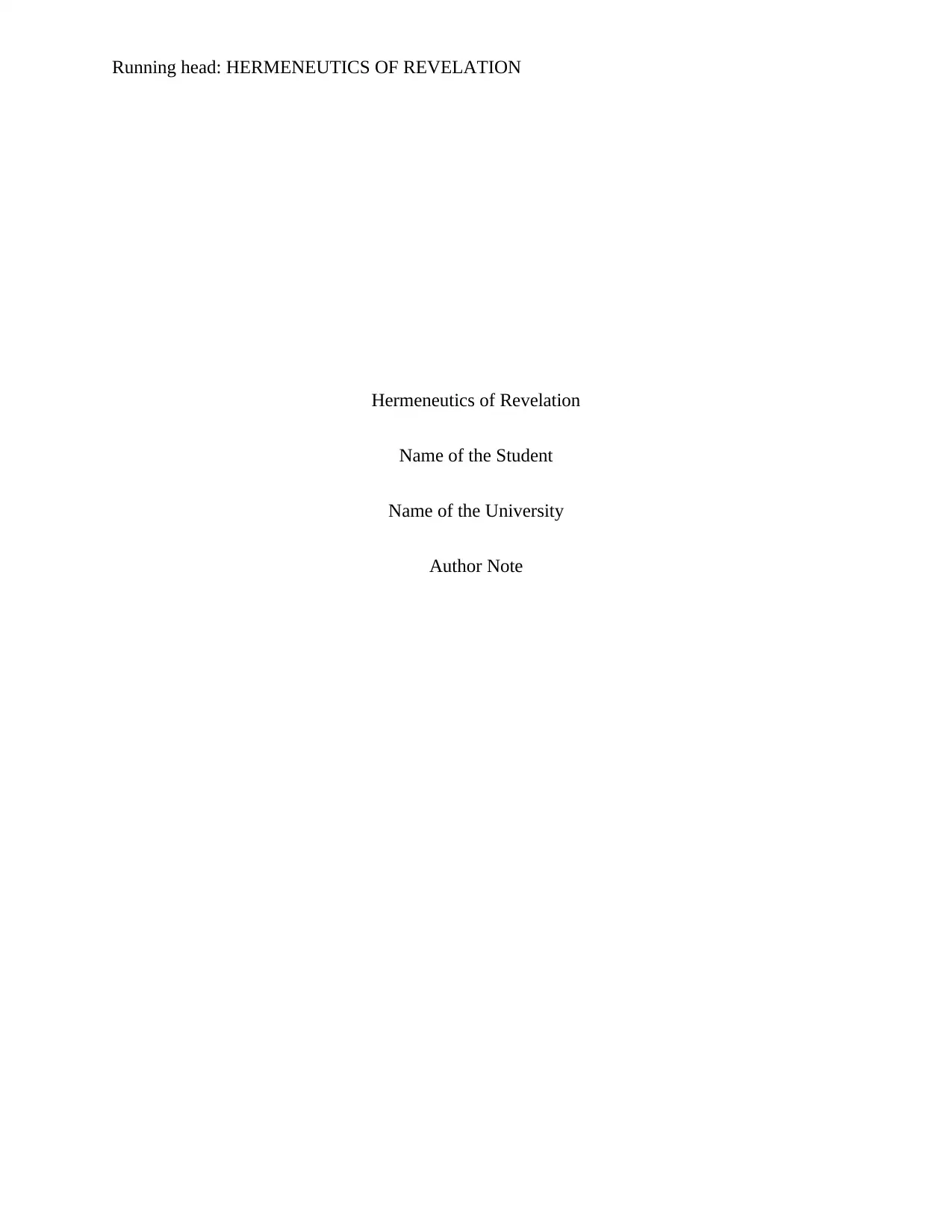
Running head: HERMENEUTICS OF REVELATION
Hermeneutics of Revelation
Name of the Student
Name of the University
Author Note
Hermeneutics of Revelation
Name of the Student
Name of the University
Author Note
Paraphrase This Document
Need a fresh take? Get an instant paraphrase of this document with our AI Paraphraser
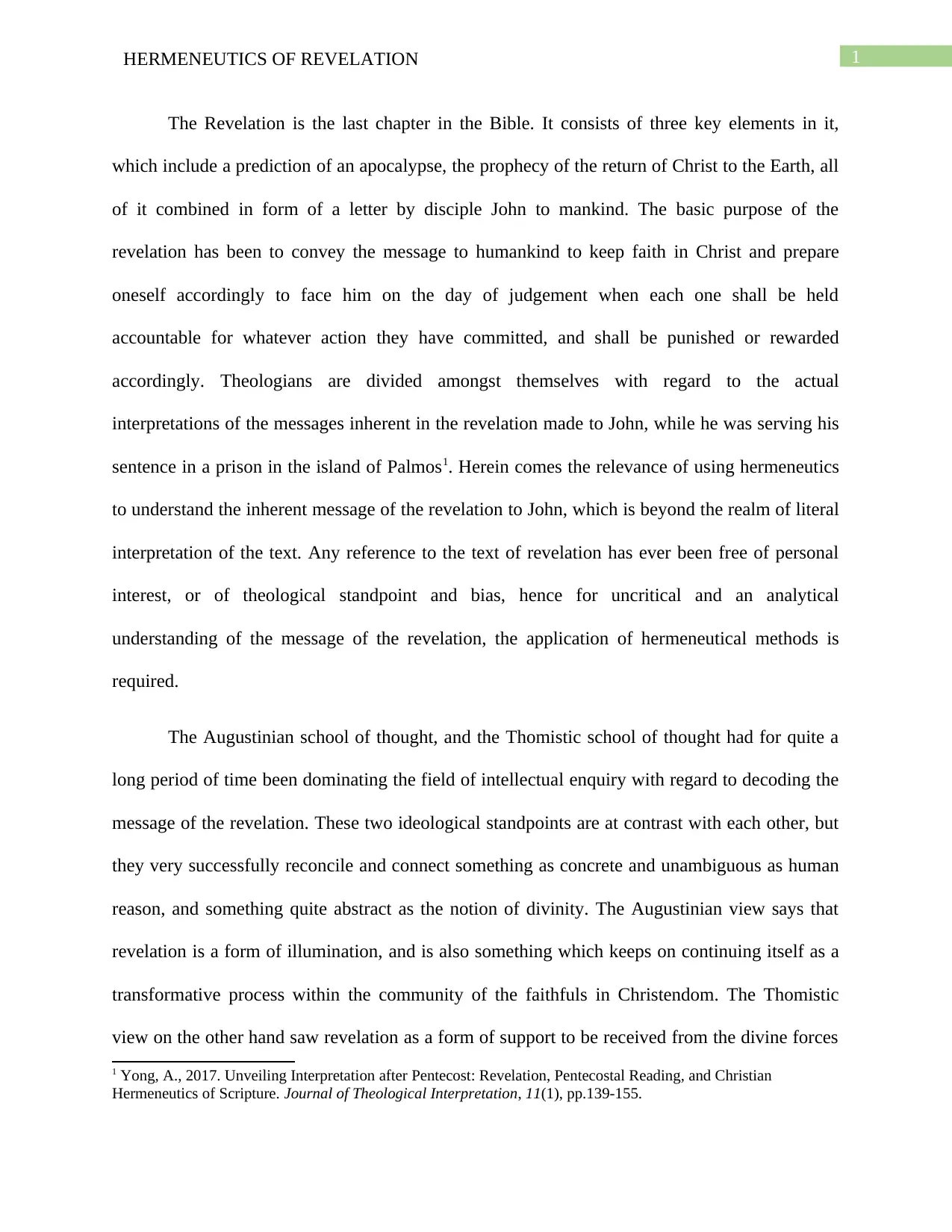
1HERMENEUTICS OF REVELATION
The Revelation is the last chapter in the Bible. It consists of three key elements in it,
which include a prediction of an apocalypse, the prophecy of the return of Christ to the Earth, all
of it combined in form of a letter by disciple John to mankind. The basic purpose of the
revelation has been to convey the message to humankind to keep faith in Christ and prepare
oneself accordingly to face him on the day of judgement when each one shall be held
accountable for whatever action they have committed, and shall be punished or rewarded
accordingly. Theologians are divided amongst themselves with regard to the actual
interpretations of the messages inherent in the revelation made to John, while he was serving his
sentence in a prison in the island of Palmos1. Herein comes the relevance of using hermeneutics
to understand the inherent message of the revelation to John, which is beyond the realm of literal
interpretation of the text. Any reference to the text of revelation has ever been free of personal
interest, or of theological standpoint and bias, hence for uncritical and an analytical
understanding of the message of the revelation, the application of hermeneutical methods is
required.
The Augustinian school of thought, and the Thomistic school of thought had for quite a
long period of time been dominating the field of intellectual enquiry with regard to decoding the
message of the revelation. These two ideological standpoints are at contrast with each other, but
they very successfully reconcile and connect something as concrete and unambiguous as human
reason, and something quite abstract as the notion of divinity. The Augustinian view says that
revelation is a form of illumination, and is also something which keeps on continuing itself as a
transformative process within the community of the faithfuls in Christendom. The Thomistic
view on the other hand saw revelation as a form of support to be received from the divine forces
1 Yong, A., 2017. Unveiling Interpretation after Pentecost: Revelation, Pentecostal Reading, and Christian
Hermeneutics of Scripture. Journal of Theological Interpretation, 11(1), pp.139-155.
The Revelation is the last chapter in the Bible. It consists of three key elements in it,
which include a prediction of an apocalypse, the prophecy of the return of Christ to the Earth, all
of it combined in form of a letter by disciple John to mankind. The basic purpose of the
revelation has been to convey the message to humankind to keep faith in Christ and prepare
oneself accordingly to face him on the day of judgement when each one shall be held
accountable for whatever action they have committed, and shall be punished or rewarded
accordingly. Theologians are divided amongst themselves with regard to the actual
interpretations of the messages inherent in the revelation made to John, while he was serving his
sentence in a prison in the island of Palmos1. Herein comes the relevance of using hermeneutics
to understand the inherent message of the revelation to John, which is beyond the realm of literal
interpretation of the text. Any reference to the text of revelation has ever been free of personal
interest, or of theological standpoint and bias, hence for uncritical and an analytical
understanding of the message of the revelation, the application of hermeneutical methods is
required.
The Augustinian school of thought, and the Thomistic school of thought had for quite a
long period of time been dominating the field of intellectual enquiry with regard to decoding the
message of the revelation. These two ideological standpoints are at contrast with each other, but
they very successfully reconcile and connect something as concrete and unambiguous as human
reason, and something quite abstract as the notion of divinity. The Augustinian view says that
revelation is a form of illumination, and is also something which keeps on continuing itself as a
transformative process within the community of the faithfuls in Christendom. The Thomistic
view on the other hand saw revelation as a form of support to be received from the divine forces
1 Yong, A., 2017. Unveiling Interpretation after Pentecost: Revelation, Pentecostal Reading, and Christian
Hermeneutics of Scripture. Journal of Theological Interpretation, 11(1), pp.139-155.
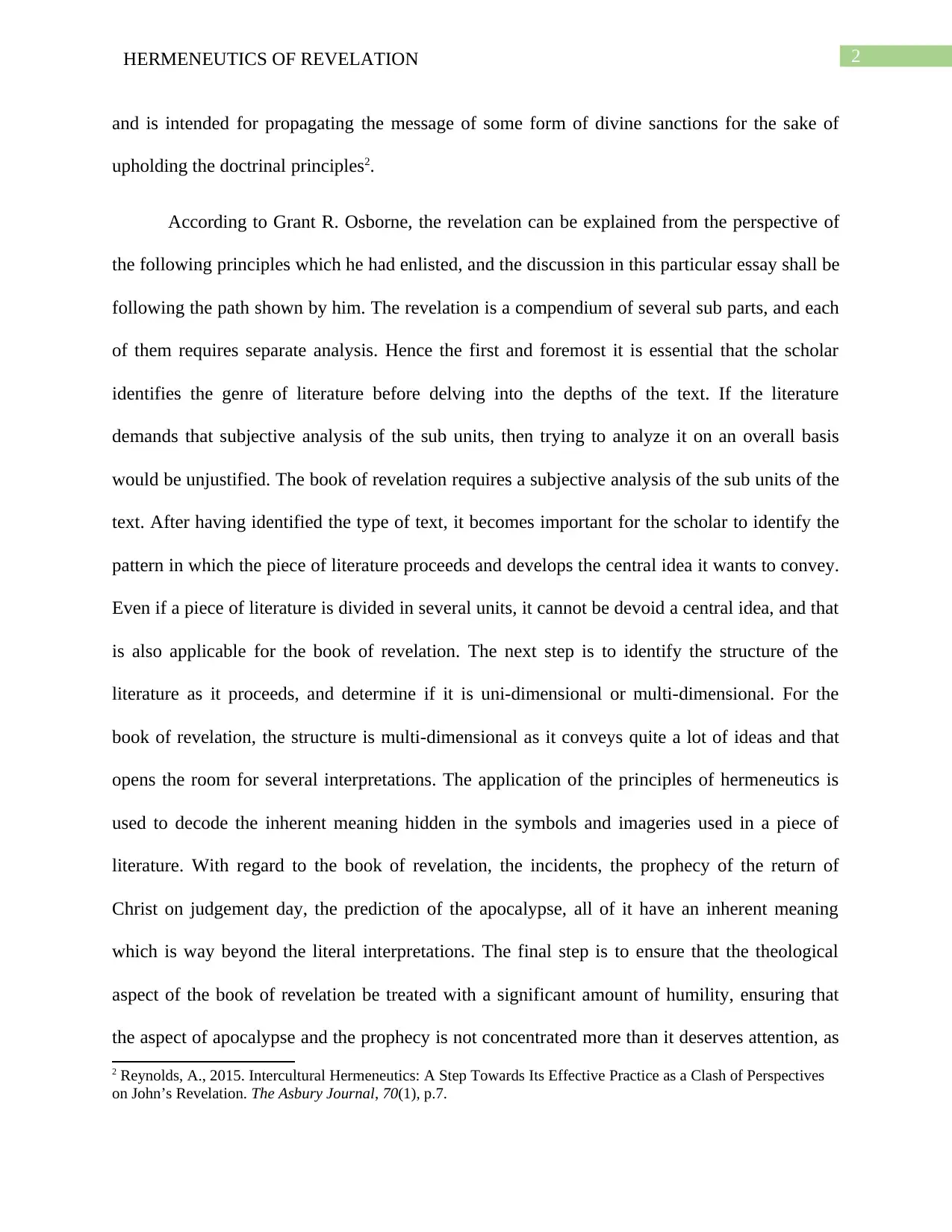
2HERMENEUTICS OF REVELATION
and is intended for propagating the message of some form of divine sanctions for the sake of
upholding the doctrinal principles2.
According to Grant R. Osborne, the revelation can be explained from the perspective of
the following principles which he had enlisted, and the discussion in this particular essay shall be
following the path shown by him. The revelation is a compendium of several sub parts, and each
of them requires separate analysis. Hence the first and foremost it is essential that the scholar
identifies the genre of literature before delving into the depths of the text. If the literature
demands that subjective analysis of the sub units, then trying to analyze it on an overall basis
would be unjustified. The book of revelation requires a subjective analysis of the sub units of the
text. After having identified the type of text, it becomes important for the scholar to identify the
pattern in which the piece of literature proceeds and develops the central idea it wants to convey.
Even if a piece of literature is divided in several units, it cannot be devoid a central idea, and that
is also applicable for the book of revelation. The next step is to identify the structure of the
literature as it proceeds, and determine if it is uni-dimensional or multi-dimensional. For the
book of revelation, the structure is multi-dimensional as it conveys quite a lot of ideas and that
opens the room for several interpretations. The application of the principles of hermeneutics is
used to decode the inherent meaning hidden in the symbols and imageries used in a piece of
literature. With regard to the book of revelation, the incidents, the prophecy of the return of
Christ on judgement day, the prediction of the apocalypse, all of it have an inherent meaning
which is way beyond the literal interpretations. The final step is to ensure that the theological
aspect of the book of revelation be treated with a significant amount of humility, ensuring that
the aspect of apocalypse and the prophecy is not concentrated more than it deserves attention, as
2 Reynolds, A., 2015. Intercultural Hermeneutics: A Step Towards Its Effective Practice as a Clash of Perspectives
on John’s Revelation. The Asbury Journal, 70(1), p.7.
and is intended for propagating the message of some form of divine sanctions for the sake of
upholding the doctrinal principles2.
According to Grant R. Osborne, the revelation can be explained from the perspective of
the following principles which he had enlisted, and the discussion in this particular essay shall be
following the path shown by him. The revelation is a compendium of several sub parts, and each
of them requires separate analysis. Hence the first and foremost it is essential that the scholar
identifies the genre of literature before delving into the depths of the text. If the literature
demands that subjective analysis of the sub units, then trying to analyze it on an overall basis
would be unjustified. The book of revelation requires a subjective analysis of the sub units of the
text. After having identified the type of text, it becomes important for the scholar to identify the
pattern in which the piece of literature proceeds and develops the central idea it wants to convey.
Even if a piece of literature is divided in several units, it cannot be devoid a central idea, and that
is also applicable for the book of revelation. The next step is to identify the structure of the
literature as it proceeds, and determine if it is uni-dimensional or multi-dimensional. For the
book of revelation, the structure is multi-dimensional as it conveys quite a lot of ideas and that
opens the room for several interpretations. The application of the principles of hermeneutics is
used to decode the inherent meaning hidden in the symbols and imageries used in a piece of
literature. With regard to the book of revelation, the incidents, the prophecy of the return of
Christ on judgement day, the prediction of the apocalypse, all of it have an inherent meaning
which is way beyond the literal interpretations. The final step is to ensure that the theological
aspect of the book of revelation be treated with a significant amount of humility, ensuring that
the aspect of apocalypse and the prophecy is not concentrated more than it deserves attention, as
2 Reynolds, A., 2015. Intercultural Hermeneutics: A Step Towards Its Effective Practice as a Clash of Perspectives
on John’s Revelation. The Asbury Journal, 70(1), p.7.
⊘ This is a preview!⊘
Do you want full access?
Subscribe today to unlock all pages.

Trusted by 1+ million students worldwide
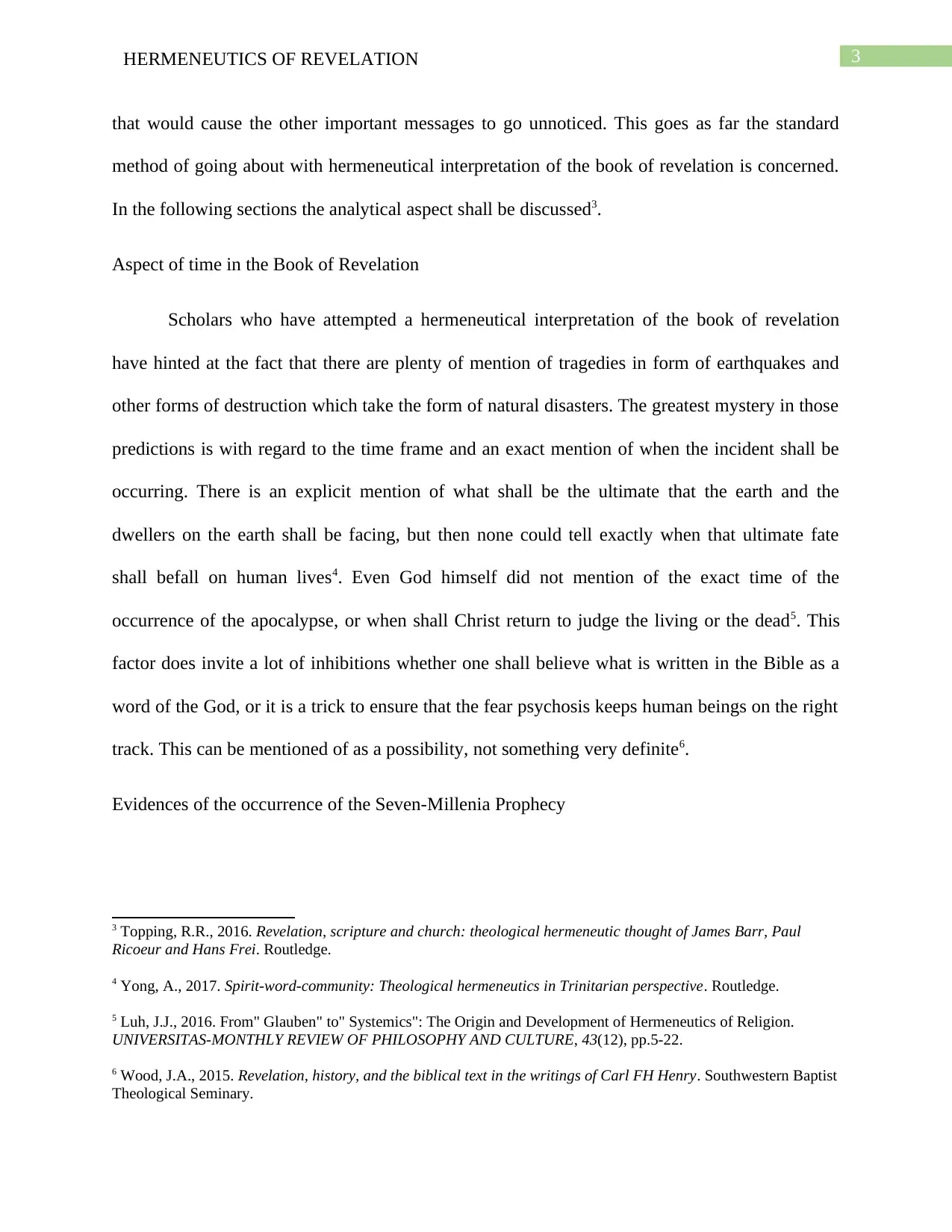
3HERMENEUTICS OF REVELATION
that would cause the other important messages to go unnoticed. This goes as far the standard
method of going about with hermeneutical interpretation of the book of revelation is concerned.
In the following sections the analytical aspect shall be discussed3.
Aspect of time in the Book of Revelation
Scholars who have attempted a hermeneutical interpretation of the book of revelation
have hinted at the fact that there are plenty of mention of tragedies in form of earthquakes and
other forms of destruction which take the form of natural disasters. The greatest mystery in those
predictions is with regard to the time frame and an exact mention of when the incident shall be
occurring. There is an explicit mention of what shall be the ultimate that the earth and the
dwellers on the earth shall be facing, but then none could tell exactly when that ultimate fate
shall befall on human lives4. Even God himself did not mention of the exact time of the
occurrence of the apocalypse, or when shall Christ return to judge the living or the dead5. This
factor does invite a lot of inhibitions whether one shall believe what is written in the Bible as a
word of the God, or it is a trick to ensure that the fear psychosis keeps human beings on the right
track. This can be mentioned of as a possibility, not something very definite6.
Evidences of the occurrence of the Seven-Millenia Prophecy
3 Topping, R.R., 2016. Revelation, scripture and church: theological hermeneutic thought of James Barr, Paul
Ricoeur and Hans Frei. Routledge.
4 Yong, A., 2017. Spirit-word-community: Theological hermeneutics in Trinitarian perspective. Routledge.
5 Luh, J.J., 2016. From" Glauben" to" Systemics": The Origin and Development of Hermeneutics of Religion.
UNIVERSITAS-MONTHLY REVIEW OF PHILOSOPHY AND CULTURE, 43(12), pp.5-22.
6 Wood, J.A., 2015. Revelation, history, and the biblical text in the writings of Carl FH Henry. Southwestern Baptist
Theological Seminary.
that would cause the other important messages to go unnoticed. This goes as far the standard
method of going about with hermeneutical interpretation of the book of revelation is concerned.
In the following sections the analytical aspect shall be discussed3.
Aspect of time in the Book of Revelation
Scholars who have attempted a hermeneutical interpretation of the book of revelation
have hinted at the fact that there are plenty of mention of tragedies in form of earthquakes and
other forms of destruction which take the form of natural disasters. The greatest mystery in those
predictions is with regard to the time frame and an exact mention of when the incident shall be
occurring. There is an explicit mention of what shall be the ultimate that the earth and the
dwellers on the earth shall be facing, but then none could tell exactly when that ultimate fate
shall befall on human lives4. Even God himself did not mention of the exact time of the
occurrence of the apocalypse, or when shall Christ return to judge the living or the dead5. This
factor does invite a lot of inhibitions whether one shall believe what is written in the Bible as a
word of the God, or it is a trick to ensure that the fear psychosis keeps human beings on the right
track. This can be mentioned of as a possibility, not something very definite6.
Evidences of the occurrence of the Seven-Millenia Prophecy
3 Topping, R.R., 2016. Revelation, scripture and church: theological hermeneutic thought of James Barr, Paul
Ricoeur and Hans Frei. Routledge.
4 Yong, A., 2017. Spirit-word-community: Theological hermeneutics in Trinitarian perspective. Routledge.
5 Luh, J.J., 2016. From" Glauben" to" Systemics": The Origin and Development of Hermeneutics of Religion.
UNIVERSITAS-MONTHLY REVIEW OF PHILOSOPHY AND CULTURE, 43(12), pp.5-22.
6 Wood, J.A., 2015. Revelation, history, and the biblical text in the writings of Carl FH Henry. Southwestern Baptist
Theological Seminary.
Paraphrase This Document
Need a fresh take? Get an instant paraphrase of this document with our AI Paraphraser
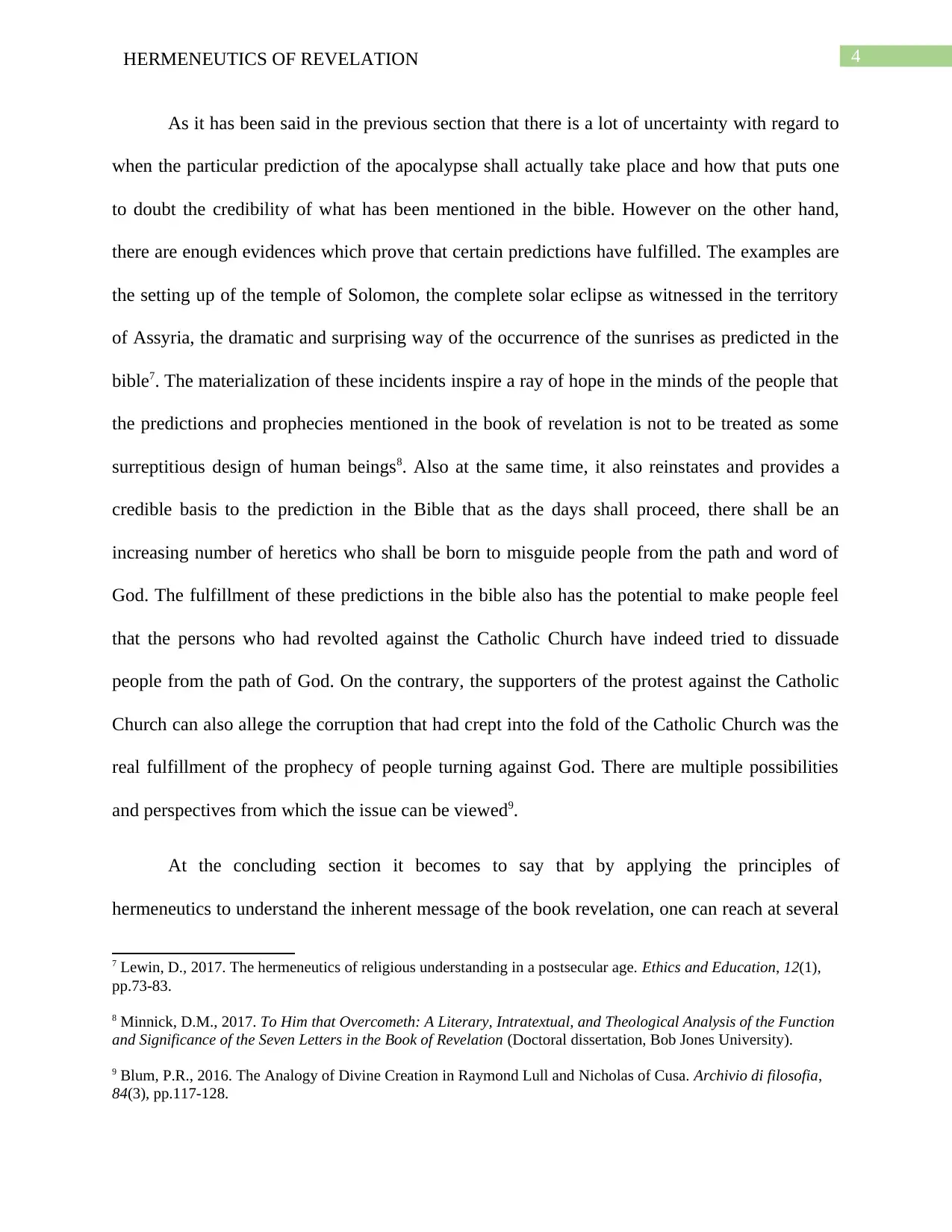
4HERMENEUTICS OF REVELATION
As it has been said in the previous section that there is a lot of uncertainty with regard to
when the particular prediction of the apocalypse shall actually take place and how that puts one
to doubt the credibility of what has been mentioned in the bible. However on the other hand,
there are enough evidences which prove that certain predictions have fulfilled. The examples are
the setting up of the temple of Solomon, the complete solar eclipse as witnessed in the territory
of Assyria, the dramatic and surprising way of the occurrence of the sunrises as predicted in the
bible7. The materialization of these incidents inspire a ray of hope in the minds of the people that
the predictions and prophecies mentioned in the book of revelation is not to be treated as some
surreptitious design of human beings8. Also at the same time, it also reinstates and provides a
credible basis to the prediction in the Bible that as the days shall proceed, there shall be an
increasing number of heretics who shall be born to misguide people from the path and word of
God. The fulfillment of these predictions in the bible also has the potential to make people feel
that the persons who had revolted against the Catholic Church have indeed tried to dissuade
people from the path of God. On the contrary, the supporters of the protest against the Catholic
Church can also allege the corruption that had crept into the fold of the Catholic Church was the
real fulfillment of the prophecy of people turning against God. There are multiple possibilities
and perspectives from which the issue can be viewed9.
At the concluding section it becomes to say that by applying the principles of
hermeneutics to understand the inherent message of the book revelation, one can reach at several
7 Lewin, D., 2017. The hermeneutics of religious understanding in a postsecular age. Ethics and Education, 12(1),
pp.73-83.
8 Minnick, D.M., 2017. To Him that Overcometh: A Literary, Intratextual, and Theological Analysis of the Function
and Significance of the Seven Letters in the Book of Revelation (Doctoral dissertation, Bob Jones University).
9 Blum, P.R., 2016. The Analogy of Divine Creation in Raymond Lull and Nicholas of Cusa. Archivio di filosofia,
84(3), pp.117-128.
As it has been said in the previous section that there is a lot of uncertainty with regard to
when the particular prediction of the apocalypse shall actually take place and how that puts one
to doubt the credibility of what has been mentioned in the bible. However on the other hand,
there are enough evidences which prove that certain predictions have fulfilled. The examples are
the setting up of the temple of Solomon, the complete solar eclipse as witnessed in the territory
of Assyria, the dramatic and surprising way of the occurrence of the sunrises as predicted in the
bible7. The materialization of these incidents inspire a ray of hope in the minds of the people that
the predictions and prophecies mentioned in the book of revelation is not to be treated as some
surreptitious design of human beings8. Also at the same time, it also reinstates and provides a
credible basis to the prediction in the Bible that as the days shall proceed, there shall be an
increasing number of heretics who shall be born to misguide people from the path and word of
God. The fulfillment of these predictions in the bible also has the potential to make people feel
that the persons who had revolted against the Catholic Church have indeed tried to dissuade
people from the path of God. On the contrary, the supporters of the protest against the Catholic
Church can also allege the corruption that had crept into the fold of the Catholic Church was the
real fulfillment of the prophecy of people turning against God. There are multiple possibilities
and perspectives from which the issue can be viewed9.
At the concluding section it becomes to say that by applying the principles of
hermeneutics to understand the inherent message of the book revelation, one can reach at several
7 Lewin, D., 2017. The hermeneutics of religious understanding in a postsecular age. Ethics and Education, 12(1),
pp.73-83.
8 Minnick, D.M., 2017. To Him that Overcometh: A Literary, Intratextual, and Theological Analysis of the Function
and Significance of the Seven Letters in the Book of Revelation (Doctoral dissertation, Bob Jones University).
9 Blum, P.R., 2016. The Analogy of Divine Creation in Raymond Lull and Nicholas of Cusa. Archivio di filosofia,
84(3), pp.117-128.

5HERMENEUTICS OF REVELATION
interpretations, whose basis cannot be considered as the sole truth. As for one strand of logic,
there can be another strand of logic trying to neutralize it. Hence, it is impossible to reach at a
definite conclusion, however none of the interpretations can be considered as baseless, just that
the possibility of a sole truth is absent.
interpretations, whose basis cannot be considered as the sole truth. As for one strand of logic,
there can be another strand of logic trying to neutralize it. Hence, it is impossible to reach at a
definite conclusion, however none of the interpretations can be considered as baseless, just that
the possibility of a sole truth is absent.
⊘ This is a preview!⊘
Do you want full access?
Subscribe today to unlock all pages.

Trusted by 1+ million students worldwide
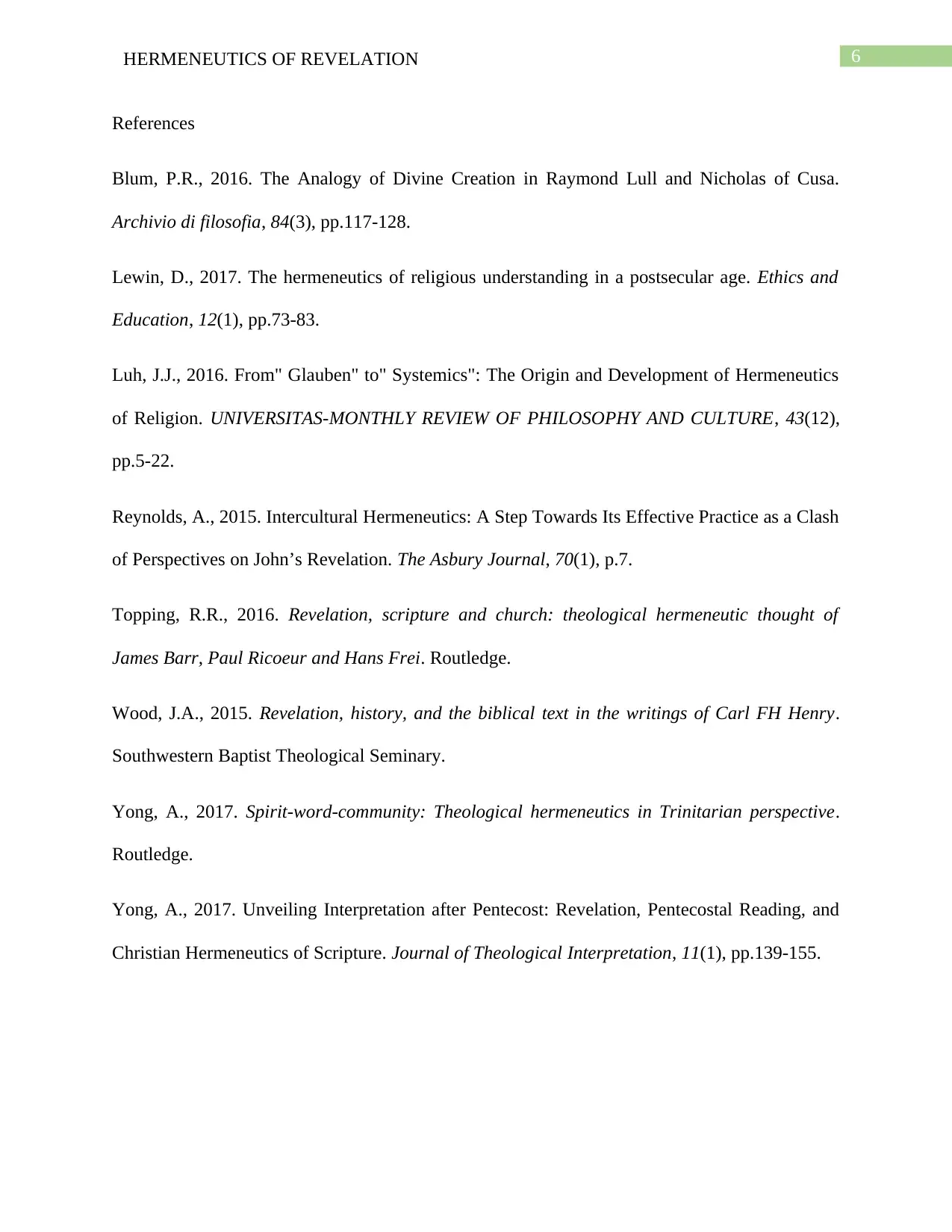
6HERMENEUTICS OF REVELATION
References
Blum, P.R., 2016. The Analogy of Divine Creation in Raymond Lull and Nicholas of Cusa.
Archivio di filosofia, 84(3), pp.117-128.
Lewin, D., 2017. The hermeneutics of religious understanding in a postsecular age. Ethics and
Education, 12(1), pp.73-83.
Luh, J.J., 2016. From" Glauben" to" Systemics": The Origin and Development of Hermeneutics
of Religion. UNIVERSITAS-MONTHLY REVIEW OF PHILOSOPHY AND CULTURE, 43(12),
pp.5-22.
Reynolds, A., 2015. Intercultural Hermeneutics: A Step Towards Its Effective Practice as a Clash
of Perspectives on John’s Revelation. The Asbury Journal, 70(1), p.7.
Topping, R.R., 2016. Revelation, scripture and church: theological hermeneutic thought of
James Barr, Paul Ricoeur and Hans Frei. Routledge.
Wood, J.A., 2015. Revelation, history, and the biblical text in the writings of Carl FH Henry.
Southwestern Baptist Theological Seminary.
Yong, A., 2017. Spirit-word-community: Theological hermeneutics in Trinitarian perspective.
Routledge.
Yong, A., 2017. Unveiling Interpretation after Pentecost: Revelation, Pentecostal Reading, and
Christian Hermeneutics of Scripture. Journal of Theological Interpretation, 11(1), pp.139-155.
References
Blum, P.R., 2016. The Analogy of Divine Creation in Raymond Lull and Nicholas of Cusa.
Archivio di filosofia, 84(3), pp.117-128.
Lewin, D., 2017. The hermeneutics of religious understanding in a postsecular age. Ethics and
Education, 12(1), pp.73-83.
Luh, J.J., 2016. From" Glauben" to" Systemics": The Origin and Development of Hermeneutics
of Religion. UNIVERSITAS-MONTHLY REVIEW OF PHILOSOPHY AND CULTURE, 43(12),
pp.5-22.
Reynolds, A., 2015. Intercultural Hermeneutics: A Step Towards Its Effective Practice as a Clash
of Perspectives on John’s Revelation. The Asbury Journal, 70(1), p.7.
Topping, R.R., 2016. Revelation, scripture and church: theological hermeneutic thought of
James Barr, Paul Ricoeur and Hans Frei. Routledge.
Wood, J.A., 2015. Revelation, history, and the biblical text in the writings of Carl FH Henry.
Southwestern Baptist Theological Seminary.
Yong, A., 2017. Spirit-word-community: Theological hermeneutics in Trinitarian perspective.
Routledge.
Yong, A., 2017. Unveiling Interpretation after Pentecost: Revelation, Pentecostal Reading, and
Christian Hermeneutics of Scripture. Journal of Theological Interpretation, 11(1), pp.139-155.
Paraphrase This Document
Need a fresh take? Get an instant paraphrase of this document with our AI Paraphraser

7HERMENEUTICS OF REVELATION
1 out of 8
Your All-in-One AI-Powered Toolkit for Academic Success.
+13062052269
info@desklib.com
Available 24*7 on WhatsApp / Email
![[object Object]](/_next/static/media/star-bottom.7253800d.svg)
Unlock your academic potential
Copyright © 2020–2025 A2Z Services. All Rights Reserved. Developed and managed by ZUCOL.
